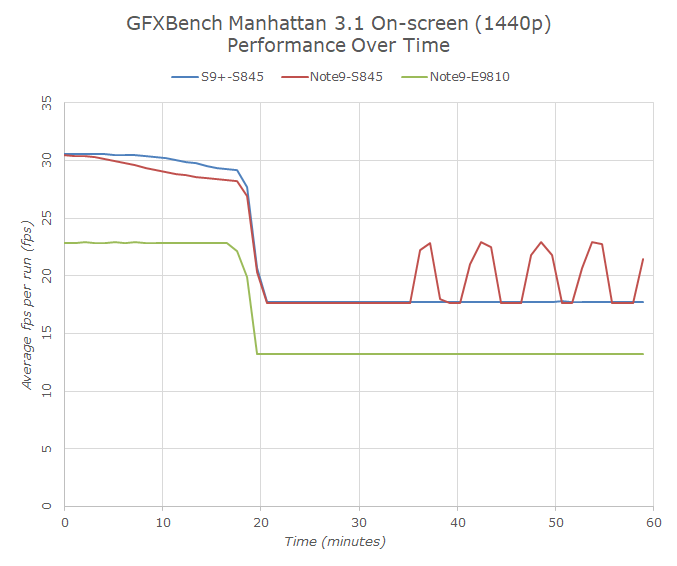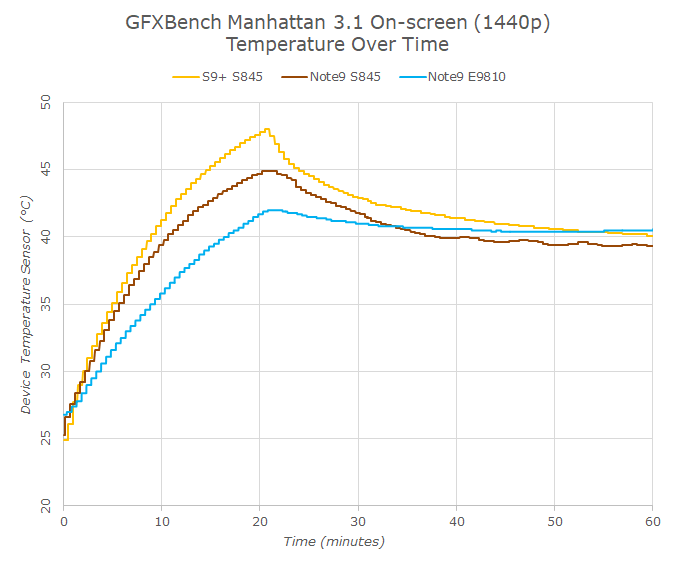Samsung Galaxy Note9 Performance & Battery Showdown: Snapdragon vs Exynos
by Andrei Frumusanu on November 26, 2018 8:00 AM ESTGPU Performance & Device Thermals
GPU performance of the Note9 shouldn’t be much of a surprise by now as we’ve covered the Snapdragon 845 and Exynos 9810 extensively in this regard. Yet, the Note9 does differ significantly in this regard because Samsung claims to have included a new massive heat-pipe and heat spreader, theoretically much improving the thermal dissipation from the SoC to the body of the phone.
I’m actually starting off this article with a test of the device’s thermals, because I found some quite weird results here that I feel are quite inexplicable in their behaviour, and something that I found to happen in quite a lot of the Snapdragon 845 devices in 2018.
I’m using the on-screen Manhattan 3.1 test in 1440p on-screen mode in a continuous loop for an hour. Besides both Note9’s, I’m also including the S9+ in order to see just how much of an effect the Note9’s new heat-pipe is able to help with performance and thermals.
Performance wise, the results are very surprising. The Snapdragon Note9 for the better part of the first 20 minutes seems to actually perform slightly worse than the S9+. Both phones look to be throttling at virtually the same identical point, which I also found to be quite weird. It’s only much later in the test, after the 35 minute mark, where the Note9 starts to fluctuate more in terms of performance, recovering to a higher GPU frequency for a few minutes before falling back to the minimum performance and continuing so forth ad infinitum.
The Exynos Note9 as expected, performs worse than the Snapdragon unit, but this shouldn’t be much of a surprise.
Actually examining the temperature reported by the phones we again see some very weird behaviour. The temperature here is as reported by an internal sensor on the phones. I don’t usually like showcasing these results because the sensors will vary between devices and vendors. This case is an exception because the sensor between the two Note9’s should be identical (battery PMIC IC), as well as very comparable to the S9+. The actual maximum skin temperature as measured by an IR thermometer are higher than the values shown here.
The one thing that again feels utterly unexplainable to me is the fact that there’s a notable change in throttling behaviour after the 20 minute mark, all seemingly unrelated to the actual temperature of the phones. The Snapdragon Note9 does report much better maximum temperatures over the S9+. The Exynos Note9 here also achieves even better temperatures, and this pretty much falls in line with the fact that the Exynos 9810’s peak power consumption in GPU workloads is actually lower than the Snapdragon 845’s.
Now this 20 minute mark in the temperatures is something that I’ve encountered more often this year across devices, yet I haven’t actually found any good evidence as to explain it. The Snapdragon Note9 showcases that it has intermediate throttling levels later on in its runtime, what puzzles me is as to why the device doesn’t set this medium frequency level earlier in the runtime when reaching the same throttling temperature?
The Snapdragon 845’s behaviour here is very weird: In our initial review of the Galaxy S9+ I mentioned that the phone entered an overheating state killing the benchmark, reaching high skin temperatures of up to 58°C. In subsequent firmware updates over the summer I wasn't able to reproduce this anymore. I actually found the same issue in the Xiaomi Mi MIX2S which was also quickly resolved with a firmware update. This lets me believe that Qualcomm actually has some sort of time-, rather than a temperature-based boost/throttle mode in the drivers of the chip. I’m very perplexed by this as I can’t discern if this is a legitimate mechanism or not.
The benchmarks
The thermal considerations being mentioned, we continue on with our standard set of benchmarks.

In the 3DMark Physics test, the Note 9 fares extremely well in terms of the sustained performance scores. Here we see quite a jump over the results of the S9+, and at the same time this makes the Snapdragon Note9 the best S845 device in this particular benchmark.
The Exynos Note9 also showcases much improved sustained performance scores much higher than that of the S9.

The 3DMark graphics results have me a bit perplexed. The Snapdragon Note9’s sustained performance scores are good- really good- too good.
We showcased that the devices do throttle after certain amount of time, yet in 3DMark I wasn’t able to actually enter this sustained state in any way on the Note9’s, even after prolonged heating. I don’t have a way to loop 3DMark in the same way I loop GFXBench, and I have to wonder if this plays a role here. The Snapdragon Note9 was allowed to get really hot here, reaching 48°C+ skin temperatures near the SoC.
I’m using obfuscated applications IDs to avoid benchmark detection – still I have some reservations about these scores on whether they’re results of genuine thermal mechanisms or something else.


Moving on to GFXBench, we’re seeing some more reasonable sustained performance results in the “High” benchmark mode. Again I have a hard time explaining why the Normal mode scores that much better for the Snapdragon Note9, here it’s maybe a side-effect of the higher ALU utilisation in the high mode which also causes higher power consumption in the Adreno 630.

In Manhattan, we see a similar result as in the Normal Aztec run, with the Snapdragon 845 Note9 maintaining excellent sustained perf.

Switching over to T-Rex, things again are more in line with previous Snapdragon 845 results. The Exynos Note9 also is behaving very similar to the S9.
I’ve ran these tests several times now and again noticed there some unexplained variability in the results that aren’t explained by the actual temperature of the phones. Under thermal stress, the Snapdragon Note9 sometimes performs excellently even at high sustained temperatures of the device, and sometimes it logically throttles as you would expect it to. It’s something I’ll have to dig in a bit more into.
In any case, the verdict here is that the Snapdragon Note9 performs excellently in terms of sustained performance. The Exynos Note9’s sustained performance in GFXBench was a lot more alike the S9 – both devices allowing for much lesser peak temperatures than the Snapdragon counterparts, but again both also showcasing significantly worse performance due to the weaker GPUs.












69 Comments
View All Comments
cha0z_ - Wednesday, November 28, 2018 - link
Excellent work and article.One question tho, why the exynos note 9 fail so bad in the GPU sustain performance? The sd845 note 9 shows great gains over the sd845 s9+ variant, why the exynos note doesn't have any gains over the exynos s9? I was expecting that both note phones will have similar benefits over the s9 respectable variants due to the better cooling?
kukuhp - Wednesday, November 28, 2018 - link
Great article Andrei, why not testing the standby drain?In my country, only available Exynos version of samsung flagship.
And i always notice exynos samsung consume more power in standby.
For example, In the same year-cpu-flagship between exynos and snapdragon, exynos will counsume at least 1% per hour in the night while i sleep, and the snapdragon about 0.3% per hour. And it will be worse in the work hour, exynos need charged in the middle of the day
cha0z_ - Thursday, November 29, 2018 - link
I am getting ~3% in 8-9h sleep on my exynos note 9. Not bad at all.128bit - Monday, December 10, 2018 - link
I’m using S9 plus Exyons 9810 and one plus 6 snapdragon 845, 8 gig of ram, 128GB of storage for couple of month now and noticed that snapdragon 845 good in gaming, but still has some overheating issue in heavy use, battrey life of plus still same as S9 plus Exyons, touch latency of one plus 6 in general not as good as S9 plus Exyons and noticed all snapdragon phones has some issue with touch latency including pixel 2xl.zamroni - Wednesday, December 12, 2018 - link
Conclusion: samsung should give up exynosgregoryzeng - Sunday, December 16, 2018 - link
Power consumption figures are easy, if you use the same hardware & software test tools on each tested smartphone.First charge to battery to 100 %. Then run tests via the input power source: external hardware cable, which will give accurate power use figures.
Second, use power-use software. These vary imo by brands, versions & models, so are not reliable.
I've used many in-line USB power devices; many brands, models, types, colors, etc. Only the test-laboratory-calibrated units, checked & used by professionals, will give true results.
cha0z_ - Monday, January 14, 2019 - link
The test should be redone on android pie (or atleast stated it's no longer valid). Massive scores bumps on everything regarding the exynos version atleast. pcmark is from 5200 to 6000 points overall, small bumps on the web and video category and massive bumps in the other 3 (writing, photo, data). GPU is seeing notable performance gains in every test too (guess it's mostly new drivers related) - 3dmark, antutu gpu, renderscript and so on (eager to test in real world, but if approximation is correct, I would guess around 10-14% increase depending on the workload and that's not bad at all given the poor state exynos 9810/mali g72 mp18 sits).Not sure how the snapdragon version is doing on android 9 tho, maybe it's also up (but I doubt it will be or atleast by that much as it was really optimised on oreo already).
cha0z_ - Saturday, January 19, 2019 - link
Correcting myself, web score is 6157 - a lot higher vs the android 8. :)Sad that this article was published before android 9 release. Not that it really matters+sd845 will always be the better SOC no matter what, but I am curious about the changes and to see scientific data about the current tuning as the exynos 9810 is closer to the sd845 in performance, but I think the battery took a hit even is slight.
Also the GPU is seeing 15% more fps in tests like gfx high/mid aztec, manhatan is up too, 3dmark too, antutu gpu too, everything. Really curious about the sustain performance and if it's closer to the sd this time as I feel it allows slightly higher heat. Oh, well... I understand this will never happens as it takes a lot of time and the topic is kinda old + getting absolute with new generation of phones around the corner.
The_Quantum_Guy - Tuesday, January 29, 2019 - link
Hey Andrei, I was looking forward to buy a Note 9. So according to you is it worth it to get an imported version from U.S. to India ???